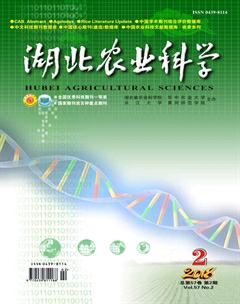三种苹果重要葡萄座腔菌DNA条形码基因的筛选
陈战+沈宏+许萍萍
摘要:葡萄座腔菌属(Botryosphaeria)真菌是导致多种水果溃烂的重要致病菌,从形态上很難区分。选取了4个DNA片段(ITS、LSU、SSU、EF-1α)作为3种重要苹果致病菌(Botryosphaeria stevensii、Botryosphaeria dothidea、Botryosphaeria obtusa)的候选条形码进行PCR扩增、Sanger测序和序列分析。结果表明,PCR扩成功率ITS>SSU>LSU=EF-1α,ITS的PCR扩增成功率达到100%;序列分析发现ITS和EF-1α基因种内序列保守,种间差异明显,而且B. dothidea菌种在EF-1α基因中存在一段100 bp左右的特异片段,可以特异区分该菌株,但核糖体基因LSU和SSU种间、种内没有明显差异;结合GenBank中的葡萄座腔属真菌ITS序列进行系统发育分析,显示3种葡萄座腔菌属菌株分别位于3个独立的分支,分析结果与形态鉴定结果一致。推荐使用ITS和EF-1α两个基因共同作为这3种葡萄座腔属真菌的条形码。
关键词:葡萄座腔菌(Botryosphaeria);苹果病原菌;条形码;EF-1α;ITS
中图分类号:S432.4 文献标识码:A 文章编号:0439-8114(2018)02-0126-06
DOI:10.14088/j.cnki.issn0439-8114.2018.02.031
Abstract: Species of Botryosphaeria are the important pathogenic fungi on many kinds of fruits. They are very always difficult to distinguish from each other based on morphological characters. In this study, to identificate of three important apple-pathogens Botryosphaeria stevensii, Botryosphaeria dothidea, Botryosphaeria obtuse. 4 gene fragments were selected, which encoded ITS、LSU、SSU、EF-1α,to be the candidate DNA barcodes. By using of PCR amplification, Sanger sequencing and data analysis,we aimed to find the molecular markers in the identification of these species. The results showed that, based on the PCR and sequencing success,it was ranked as follow:ITS>SSU>LSU=EF-1α,and ITS primer worked best(100%). According to the acquired sequences,ITS and EF-1α were quite conserved among different strains of the same species,and have the significant differences between the species. Meantime,a region of EF-1α (approx. 100 bp) was exclusively existed in the investigated strains of B. dothidea,which therefore could be used for the distinction of this species. However,the sequences of LSU and SSU have the same variation within and between the species. Combining the available ITS sequences in GeneBank,we constructed maximum likelihood tree to identify the phylogenetic relationships of Botryosphaeria. The results showed that three investigated species belonged to three monophyletic clades. These results were congruent with the taxonomic units based on the morphological characters. Accordingly, we recommended the usage of ITS and EF-1α to be the efficient molecular makers in the identification of B. stevensii、B. dothidea、B. obtuse.
Key words: Botryosphaeria;apple pathogen;barcode;EF-1α;ITS
葡萄座腔菌属(Botryosphaeria)真菌分布广泛,是果树常见的致病菌,能够引起果树的枝干坏死、果实溃疡和轮纹等症状[1,2]。在苹果上常见该类致病菌主要有3种:苹果壳色单隔孢溃疡病菌(Botryosphaeria stevensii)、葡萄座腔菌(Botryosphaeria dothidea)和钝葡萄座腔菌(Botryosphaeria obtusa)[3]。而且苹果壳色单隔孢溃疡病菌(Botryosphaeria dothidea B. stevensii)已被列为中国进境植物检疫性有害生物。该菌株除了苹果以外,还可危害葡萄、橡树、榆树、枇杷等11个科18个属的植物[4]。研究发现,葡萄座腔菌属菌株的无性型和有性型等形态特征非常相似,很难进行准确区分鉴定[5]。endprint
随着分子生物学技术的发展与应用,大大提高了物种鉴定的效率与准确性。DNA条形码(DNA Barcode)是近年来世界广泛使用的一种分子生物学检测手段[6,7]。在葡萄座腔球菌属真菌中检验过的DNA条形码包括rDNA-ITS[8]、β-tubulin[9]和IJS[10]等,但能够精确鉴定葡萄座腔属真菌的通用分子标记还鲜见报道。
本试验以2015-2016年从苹果中分离的14株葡萄座腔菌属真菌为研究对象,根据真菌进化树(Tree of funngi)网站推荐的4种常用的真菌标签及NCBI基因库中已有的葡萄座腔真菌序列(ITS、SSU、LSU、EF-1α)设计通用引物,利用ITS和EF-1α两个基因共同作为这3种葡萄座腔菌的分子标记。同时在EF-1α基因上找到了能准确鉴定B. dothidea的一段100 bp左右的特异片段,为快速鉴定苹果壳色单隔孢溃疡病菌、葡萄座腔菌和钝葡萄座腔菌提供了分子检测方法。
1 材料与方法
1.1 菌种
2015-2016年间苹果上的Botryosphaeria属病原菌见表1。
1.2 菌丝DNA提取
将菌株接种于苹果上,将存在病斑的表皮从苹果上分离,置于PDA固体培养基上,25 ℃恒温培养3~5 d,直至真菌生长达到对数期后,挑取菌落进行DNA的提取。真菌DNA提取采用改进的CTAB方法[11],DNA存放于-20 ℃冰箱保存。
1.3 PCR扩增、测序
50 μL的PCR反应体系,包括10 μmol/L上下游引物各1 μL、0.25 μL Taq DNA聚合酶(Qiagen)、5 μL 10×Buffer、1 μL 10 mmol/L dNTPs、3.5 μL MgCl2以及100~200 ng DNA模板,最后加入ddH2O补足至50 μL。PCR反应条件为95 ℃预变性5 min;95 ℃变性30 s,最佳退火温度(ITS 55 ℃、SSU 52 ℃、LSU 42 ℃、EF-1α 51 ℃)退火30 s,72 ℃延伸,35个循环;最后72 ℃延伸10 min。PCR产物用0.8%琼脂糖凝胶电泳检测,然后采用胶回收试剂盒(Qiagen)纯化产物,送至Life Technologies公司进行序列测定。为保证测序的准确性,采用双向测序,PCR扩增引物见表2[12-15]。
1.4 序列差异分析
用SeqMan 7.1.0软件进行正反向序列的拼接以及BioEdit 7.1.3软件校正序列。采用MegAlign 7.1.0软件中Cluster W进行全局比对和BLAST进行局部比对[16];BLAST软件采用默认的DNA分值系统,所有生物信息数据用于评估各基因的碱基多样性和差异。
1.5 系统发育分析
通过序列比对,在GenBank中寻找抑制的葡萄座腔菌属物种的相应序列。所有物种的序列,利用Muscle软件[17]进行ITS序列比对,然后采用MrBayes v3.2.6软件[18]中贝叶斯推理方法构建系统发育树,进化树评估通过运行10 000 000代,每100代进行抽样一次。
2 结果与分析
2.1 DNA提取、PCR扩增和测序结果
供试菌株提取的DNA样品质量浓度范围为200~1 200 ng/μL,OD260 nm/OD280 nm在1.8~2.0范围内,OD260 nm/OD230 nm在2.0~2.5范围内。所有测序获得的序列已提交GenBank并获得登入号(表1)。同时对4种候选基因的引物扩增和测序的情况进行了统计,其中ITS的引物成功率达到100%,SSU的引物成功率为92.8%(13/14),LSU和EF-1α都为85.7%(12/14)。
2.2 序列比对
对于样品DNA序列编辑校正后,获得507 bp ITS共同区域,817 bp LSU共同区域,320 bp SSU共同区域,770 bp EF-1α共同区域。然后采用Bioedit软件中的Cluster W全局比对[19],统计了序列之间的碱基多样性。同时采用BLAST软件进行种内、种间差异分析,先采用makeblastdb命令将基因序列建立本地数据库,然后采用blastn输入序列与数据库比对得到所有序列之间的比对信息。
ITS序列比对结果(表3)显示,这3种真菌种内差异为B. obtusa(0~0.6%)、B. stevensii(0%)、B. dothidea(0~0.42%);种间差异B. dothidea与B. obtusa相比为7.0%~8.0%,B. dothidea与B. stevensii相比为6.25%~6.78%,B. obtusa与B. stevensii相比为2.5%~3.0%,所有序列在很多位点上都发生了明显的种间变异。
EF-1α序列比对结果(表4)显示,3种真菌种内差异为B. obtusa(0~0.55%)、B. stevensii(0%)、B. dothidea(0~2%);种间差异B. dothidea与B. obtusa相比为2.0%~2.6%,B. dothidea與B. stevensii相比为2.4%~2.6%,B. obtusa与B. stevensii相比为2.65%~3.20%;同时EF-1α序列全局比对后发现B. dothidea菌株序列比其他参试菌株序列长100个碱基,差异序列通过R软件中apex包可视化如图1所示。
LSU序列比对结果(表5)显示,种内没有差异,相似性为100%;种间差异B. dothidea与B. obtusa相比为2.2%~2.4%,B. dothidea与B. stevensii相比为2.2%~2.4%,B. obtusa与B. stevensii相比为0.4%~0.5%。全局比对发现B. dothidea有很多碱基位点种内保守,种间差异较大,但B. obtusa与B. stevensii相比仅有3个碱基的种间差异。endprint
SSU序列比对结果(表6)显示,3种真菌种内种间差异都非常小,全局比对发现仅有B. dothidea菌株在个别位点种内保守,种间发生了变异(表7)。
2.3 系统发育分析
通过BLAST比对,在GenBank中找到已知相同ITS片段的Botryosphaeria属菌株18株,但未发现与本试验扩增的EF-1α相同片段的Botryosphaeria属菌株。在系统发育分析中,通过供试菌株和GenBank库中获得的相关菌种的ITS序列以及3种外类群Pseudofusicoccum adansoniae、Pseudofusicoccum kimberleyense、Pseudofusicoccum ardesiacumn菌株ITS序列构建MrBayes进化树(图2)。在进化树中,发现3种供试菌株与NCBI数据库中的同种菌株分别聚在同一独立分支上。Botryosphaeria stevensii和Botryosphaeria obtusa菌株两个独立分支明显,与其他菌种距离都较远。同时,Botryosphaeria stevensii菌株分支的置信值为59%,Botryosphaeria obtusa菌株独立分支的置信值为100%。但Botryosphaeria dothidea菌株与同属内的很多菌种距离较近,甚至与Botryosphaeria corticis和Botryosphaeria ramosa物种聚在同一个分支上,进化分支的置信值为67%,同时3种外类群独立分开于Botryosphaeria属物种。
3 讨论
本研究通过对ITS、LSU、SSU、EF-1a 4种分子标记的引物成功率、种内种间差异、系统进化关系进行了全面分析,4种候选基因的PCR扩增成功率ITS>SSU>LSU=EF-1α。在物种鉴定方面,采用的ITS引物(ITS1/ITS4)在3种苹果病原菌中表现最好,PCR扩增成功率达到100%;扩增序列在种间及种内的差异明显,具有清晰的分子鉴定特征。ITS1-ITS4间约500 bp的序列作为分子标记,结果表明,该段序列在参试的3种葡萄座腔菌属物种的种内相似度大于99.5%,而种间相似度则小于98.5%。张露茜等[21]曾采用ITS4-ITS5序列对苹果壳色单隔孢溃疡病菌进行分子辅助鉴定,而赵娜等[22]通过对国内119株葡萄座腔菌属菌株ITS1-ITS4区段的测序,发现该属菌株在该区段上存在种内及种间的序列差异,但差异不是特别明显。该结果与本试验中ITS的测序结果相同,因此认为该区段的鉴定结果仍需其他分子标记的辅助。而本试验采用的EF-1α片段在Botryosphaeria obtusa与Botryosphaeria stevensii菌株中存在2.65%~3.20%差异率,同时翻译成氨基酸序列也在多位点发生差异;而且在B. dothidea菌株EF-1α基因内具有一段100 bp左右的特异片段,能够从PCR扩增片段的长度上特异性地鉴定出该菌种。SSU基因几乎没有条码间隔,物种鉴定能力最差。LSU基因条码间隔优于SSU,Botryosphaeria dothidea菌种相比较有一定的种间差异;但是考虑PCR扩增和测序错配的可能性,Botryosphaeria obtusa与Botryosphaeria stevensii菌株LSU基因之间0.4%~0.5%差异度几乎不能区分。
ITS系统发育树中,对整个Botryosphaeria属的进化关系分析发现Botryosphaeria stevensii菌株在整个属内进化距离较远。这与很多前人研究一致,B. stevensii分类地位存在分歧[23]。同时Botryosphaeria dothidea菌种与同属内的很多菌种距离较近,甚至与Botryosphaeria corticis和Botryosphaeria ramosa物种聚在同一个分支上。相关研究也发现Botryosphaeria dothidea种群内部存在着较为丰富的RAPD多态性,从不同地理环境来源的菌株之间会存在基因差别[24]。同时Botryosphaeria dothidea和Botryosphaeria ribis也无明显差异,甚至被很多研究认为为同种菌株。通过ITS单个基因不能完全鉴定出Botryosphaeria dothidea 菌株,需要其他基因的辅助鉴定[22]。
因此,推荐利用ITS和EF-1α基因共同作为Botryosphaeria stevensii、Botryosphaeria dothidea、Botryosphaeria obtusa这3种苹果致病菌的分子标记,可以满足对苹果上这3种病原菌的准确、快速鉴定的需要。
参考文献:
[1] SLIPPERS B,ROUX J,WINGFIELD M J,et al. Confronting the constraints of morphological taxonomy in the Botryosphaeriales[J].Persoonia,2014,33:155-168.
[2] 王 璠,黃俊斌,李国怀.葡萄座腔菌属(Botryosphaeria)引起的果树病害及研究进展[J].植物学报,2013,39(6):7-13.
[3] 韩青梅,王婧群,林月莉,等.葡萄座腔菌Botryosphaeria dothidea侵染及其对苹果果实影响的组织细胞学研究[J].真菌学报,2014,33(1):36-46.
[4] VAN NIEKERK J,CROUS P J,et al. DNA phylogeny,morphology and pathogenicity of Botryosphaeria species on grapevines[J].Mycolagia,2004,96(4):781-798.endprint
[5] LYNCH S C,ESKALEN A,ZAMBINO P J,et al. Identification and pathogenicity of Botryosphaeriaceae species associated with coast live oak(Quercus agrifolia) decline in southern California[J].Mycologia,2013,105(1):125-140.
[6] VELMURUGAN S,PRASANNAKUMAR C,MANOKARAN S. DNA barcodes for marine fungal identification and discovery[J].Fungal Ecology,2013,6:408-418.
[7] SCHOCH CL,SEIFERT KA,HUHNDORF S,et al. Nuclear ribosomal internal transcribed spacer(ITS) region as a universal DNA barcode marker for Fungi[J].PNAS,2012,109(16):6241-6246.
[8] DENTINGER B T M,DIDUKH M Y,MONCALVO JM. Comparing COI and ITS as DNA Barcode Markers for Mushrooms and Allies (Agaricomycotina)[J].PLoS One,2012,6(9):1-8.
[9] WIKEE S,LOMBARD L,NAKASHIMA C,et al. A phylogenetic re-evaluation of Phyllosticta(Botryosphaeriales)[J].Studies in Mycology,2013,76:20-29.
[10] SLIPPERS B,ROUX J,WINGFIELD M L. Confronting the constraints of morphological taxonomy in the Botryosphaeriales[J].Persoonia,2014,33:155-168.
[11] M?魻LLER EM,BAHNWEG G,SANDERMANN H,et al. A simple and efficient protocol for isolation of high molecular weight DNA from filamentous fungi,fruit bodies,and infected plant tissues[J].Nucleic Acids Res,1992,20:6115-6116.
[12] WHITE T J,BRUNS T,LEE S,et al. Amplifcation and direct sequencing of fungal ribosomal RNA genes for phylogenetics. In:PCR Protocols:a guide to methods and applications (Innis MA,Gelfand DH,Sninsky JJ,White TJ,eds)[J].Academic Press 1990,9:315-322.
[13] BORNEMAN J,HARTIN R J. PCR primers that amplify fungal rRNA genes from environmental samples[J].Applied and Environmental Microbiology,2000,66(10):4356-4360.
[14] VILGALYS R,HESTER M. Rapid genetic identification and mapping of enzymatically amplified ribosomal DNA from several Cryptococcus spp.[J].Bacteriol,1990,172:4238-4246.
[15] REHNER S A,BUCKLEY E A. Beauveria phylogeny inferred from nuclear ITS and EF1-alpha sequences:Evidence for cryptic diversification and links to Cordyceps teleomorphs[J].Mycologia,2005,97:84-98.
[16] HUNG J H,WENG Z P. Sequence Alignment and Homology Search with BLAST and Clustal W[J].Cold Spring Harb Protoc,2016,DOI:10.1101/pdb.prot093088.
[17] EDGAR R C.Muscle:Multiple sequence alignment with high accuracy and high throughput[J].Nucleic Acids Research,2004, 32:1792-1797.
[18] DRUMMOND A J,SUCHARD M A,XIE D,et al. Bayesian phylogenetics with BEAUti and the BEAST 1.7[J].Molecular Biology and Evolution,2012,29:1969-1973.
[19] HALL T A. BioEdit:A user-friendly biological sequence alignment editor and analysis program for Windows 95/98/NT[J].Nucleic Acids Symposium Series,1999,41:95-98.
[20] LYNCH S C,ESKALEN A,ZAMBINO P J,et al. Identification and pathogenicity of Botryosphaeriaceae species associated with coast live oak (Quercus agrifolia) decline in southern California[J].Mycologia,2013,105(1):125-140.
[21] 張露茜,宋绍祎,焦彬彬,等.进境水曲柳原木中苹果壳色单隔孢溃疡病菌的检疫鉴定[J].植物检疫,2015,29(1):25-29.
[22] 赵 娜,张伟伟,高小宁,等.中国部分省份苹果轮纹病菌及相关类群的系统学关系[J].西北农林科技大学学报,2011,39(10):55.
[23] SLIPPERS B,BOISSIN E,PHILLIPS A J,et al. Phylogenetic lineages in the Botryosphaeriales:A systematic and evolutionary framework[J].Stud Mycol,2013,76(1):31-49.
[24] PHILLIPS A J,RUMBOS I C,ALVES A,et al. Morphology and phylogeny of Botryosphaeria dothidea causing fruit rot of olives[J].Mycopathologia,2005,159(3):433-439.endprint

